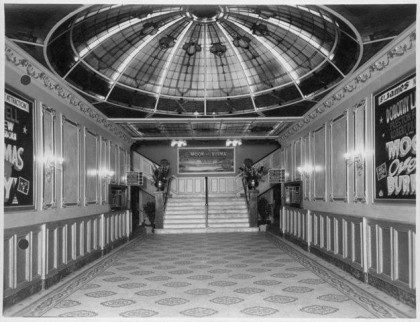Author: Phoebe Wilkins
Sadly, at the end of May, the Palace Theatre had her final curtain call, bringing to a close many years entertaining Victoria.
Just like the performers who have graced her stage, The Palace Theatre took on a myriad of identities throughout her 154 years of operation, experiencing arson, the depression, the ‘talkies’, musical theatre and some of the best live music acts from Australia and abroad.

Palace Theatre, Melbourne - Public Record Office Victoria (PROV) holds the Public Building files for the Palace Theatre.
These records reflect the less romantic side of managing a long running performance space, but tell fascinating tales of health inspections, elaborate building plans, arson, criminal proceedings and health concerns from the 1920s until the late 1980s.
Here is just a peek behind the curtain of the iconic Palace Theatre.
Sir Benjamin Fuller the Vaudeville King
Before 1920 the Palace Theatre had several guises; most notably as the Douglas Hotel which burnt to the ground in 1911. Its new owner, theatre entrepreneur Sir Benjamin “Ben” Fuller, launched The Palace Theatre in 1916 and kept it running until it could no longer compete with the spread of popular film. Sir Benjamin Fuller started on the stage at the Savoy Theatre in London before crossing the seas and settling in Sydney. Sir Benjamin and his brother John became the directors of John Fuller & Sons and prospered in the pantomime and vaudevillian business, bringing vaudeville to Melbourne and the Palace Theatre.
‘On careful reflection I'd say that Sir Benjamin Fuller was the greatest of all Australian proprietors-managers,’ claimed illusionist ‘Doctor’ Richard Rowe. ‘He controlled more theaters at one time than any man here, his shows ranging from Punch and Judy to grand opera. There were times when he juggled hundreds of acts between Perth and the Bluff, New Zealand. (Live Performance Australia, Hall of Fame)
Re-modelling for Cabaret and 'The Talkies'
In 1922 the brothers went into partnership with American actor and producer Hugh J. Ward and remodelled the Palace and the Princess Theatres in Melbourne. Remodelling included an application for ‘the use of the basement as a cabaret club’ and an ‘unauthorised doorway between the dress circle foyer and the stairway’, as well as an unsuccessful application for a revolving stage. How scandalous!
By the mid 1930s the Fuller brothers, gave the Palace Theatre another facelift with the aid of D. F. Cowell Ham and changed its name to the Apollo Theatre.
In 1936 the Apollo Theatre was not just changing its name but also its purpose. Prior to it becoming the Apollo, the theatre was used predominately for theatrical stage performances. However, by 1937, with an unsuccessful season of Noel Coward’s Fallen Angels the owners made the move to ‘show pictures permanently’.
The depression had presumably taken its toll on live theatre. In 1940 Sir Fuller made an application to the Health Department about the proposed alterations regarding improvements to the Apollo Theatre. ‘I don’t want to stress the obvious and I don’t want to make this a sob story, but I would like to point out the extremely bad time the legitimate theatre has gone through in the past few years and with the expenditure of ₤6000 I will not only be giving employment, but I consider I shall be adding to Melbourne’s social amenities.’
Metro Theatre and the Rat Problem
With the era of film came new names. Firstly St James’ Picture Theatre in 1940 (open until 11pm) and a decade later, The Metro. The US company Metro Goldwyn Mayer first became the sole lessee and then purchased the space in 1951 from the Fuller brothers. The beginning of a new decade brought new problems including a rat infestation. The rat infestation drew complaints from customers as they were seen ‘racing across the centre aisle from one side to the other then would go under seats, and on to an empty seat.’ Mrs Trinnick from Northcote had not been the first to witness these rogue rodents in the theatre, which had made their way in from the eateries on Turnbull Alley and had been an ongoing problem for the Health Department and guests alike.
A sign of the times also included a limit on wheelchairs: only one was allowed at any one time, and definitely not on Saturday nights.
1970s Musical Theatre
It wasn’t until 1971 that the theatre was hitting the headlines again. After a successful season in Sydney, the musical Hair transferred to Melbourne and to the Metro Theatre. Drama had followed the controversial stage play about conscription into the Vietnam War, and Melbourne’s season was no exception.
By December the producer of Hair, Harry M. Miller Attractions, was engaged in legal proceedings with the Melbourne City Council. The Council had banned the use of naked kerosene-fuelled flame on the stage, which Mr Miller had ignored. Naked performers however didn’t appear to contravene any by-laws.
From Church Hall to Music Hall
By the end of the decade the Metro ceased to operate but was saved from demolition when it was bought by the Melbourne Revival Centre and became a house of worship. It was then refurbished again into the Metro Nightclub, before finally and most graciously, being returned to its ‘heyday’ name of the Palace Theatre, where Australian and international acts have been performing up until now.
And So We Bid You Farewell
The famous landmark has witnessed many dramatic events. With rumours of a ghost haunting its visitors and a tunnel connecting the theatre with Her Majesty’s Theatre for horses and chariots to appear on stage. If the walls of the theatre could talk this iconic Melbourne venue would tell tales of thespians, musicians, vaudeville stars and the backstage antics of local and international stars spanning 100 years.
Links
To view any of the records used in the above flickr set, please order these records online and view them in the Melbourne Reading Room or contact our research staff directly by email.
